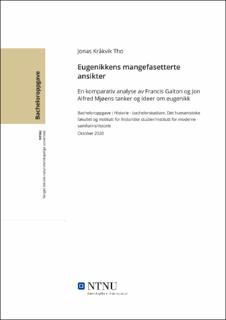| dc.contributor.advisor | Miscali, Monica | |
| dc.contributor.author | Tho, Jonas Kråkvik | |
| dc.date.accessioned | 2021-09-13T16:06:07Z | |
| dc.date.available | 2021-09-13T16:06:07Z | |
| dc.date.issued | 2020 | |
| dc.identifier | no.ntnu:inspera:67960342:22997791 | |
| dc.identifier.uri | https://hdl.handle.net/11250/2775655 | |
| dc.description.abstract | Fra slutten av 1800-tallet og utover 1900-tallet mot 2. verdenskrig, stod eugenikken som førende biologisk teori i Europa. Det 19. århundre var en periode med massiv endring og vitenskapelig optimisme, der nyvinningene innenfor biologi, psykologi og antropologi la grunnlaget for en ny fasinasjon for mennesket. Det var i denne atmosfæren eugenikken blomstret opp, som en ny måte å kategorisere og vurdere mennesker på etter en tiltenkt verdi. Eugenikkens mål om å forbedre menneskeheten gjennom en nøyere selektering av forplanting skapte stor iver i de akademiske kretsene i Europa, og man så flere forkjempere for teorien tre frem i flere nasjoner. To av disse forkjemperne ble eugenikkens fremste talsmenn i sine respektive land, Francis Galton i England og Jon Alfred Mjøen i Norge. Mellom 1857 og 1940 forfattet begge disse aktørene flere verk som tok for seg eugenikkens mål og teorier, men den dag i dag finner man få akademikere som er villig til å forsvare eugenikkens ideer. Dette er grunnet i at eugenikkens relative korte levetid i stor grad ble avsluttet med 2. verdenskrig, da tanker om selektering av mennesker basert på etnisitet ble sett på i assosiasjon med nazisme, og forkastet. Likevel kan man fremdeles finne flere spor av det tankegodset som forplantet seg i denne perioden i moderne rasisme, og eugenikkens ideer om eksistensen av «overmennesker» lever i den beste velvære hos høyreekstremister verden over. | |
| dc.description.abstract | By the end of the 19th century and continuing during 20th century towards the second world war, the eugenics movement became the leading biological theory in Europe. The 19th century was a period of massive change and scientific optimism, where innovations in the field of biology, psychology and anthropology laid the groundwork for a newfound fascination towards humans. It was in this atmosphere the theory of eugenics bloomed into prominence, as a new way to categorize and assess humans based on an imagined value. The eugenic goal of improving humanity by a more careful selection of breeding exited the academic communities in Europe, and several prominent advocates for the theory sprang up in several nations. Two of these advocates became the biggest promoters of eugenics in their respective country, Francis Galton in England and Jon Alfred Mjøen in Norway. Between 1857 and 1940, these two men authored several works of writing which concerned the goals and theories og eugenics, although today one would be hard pressed to find many academics who defend eugenic ideas. The reason for this being that the eugenics movements relatively short lifespan ended with the second world war, as ideas of selection based on ethnicity became associated with Nazism, and disregarded. Nevertheless, one can still find traces of the thoughts that gained a foothold during the period in modern day racism, and the eugenic ideas of “superior humans” still lives on in the minds of right-wing extremists the world over. | |
| dc.language | | |
| dc.publisher | NTNU | |
| dc.title | Eugenikkens mangefasetterte ansikter | |
| dc.type | Bachelor thesis | |
